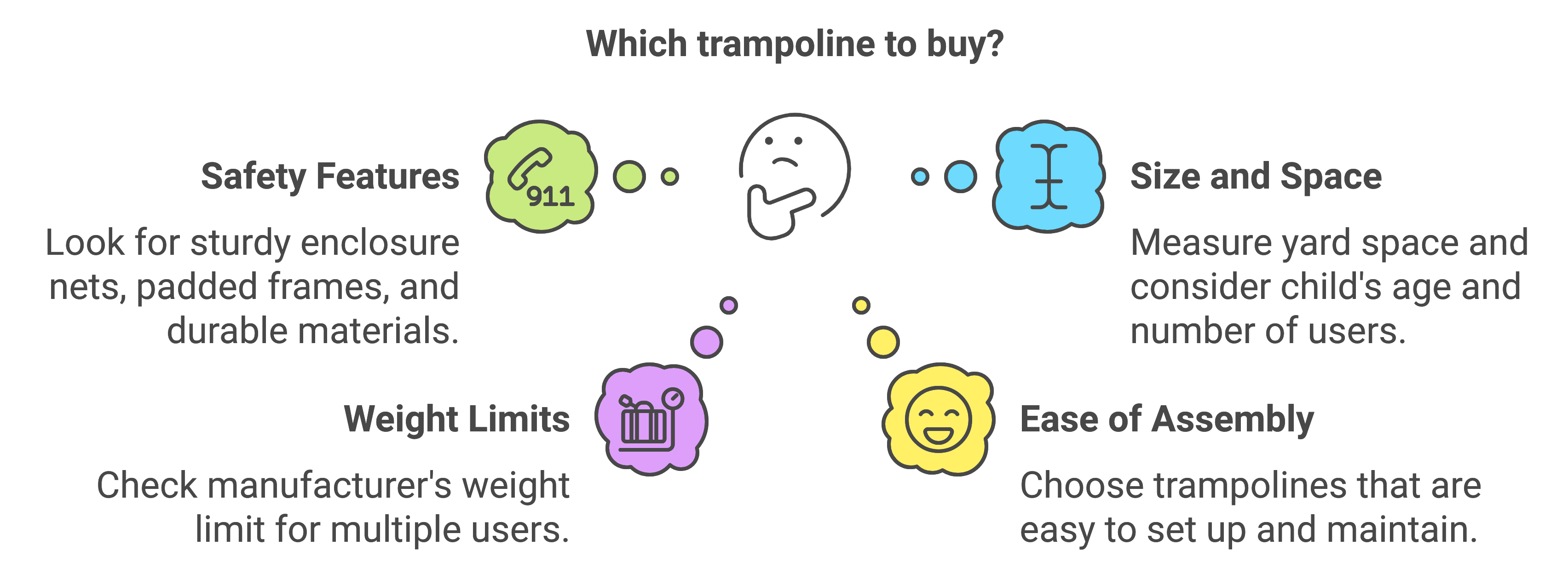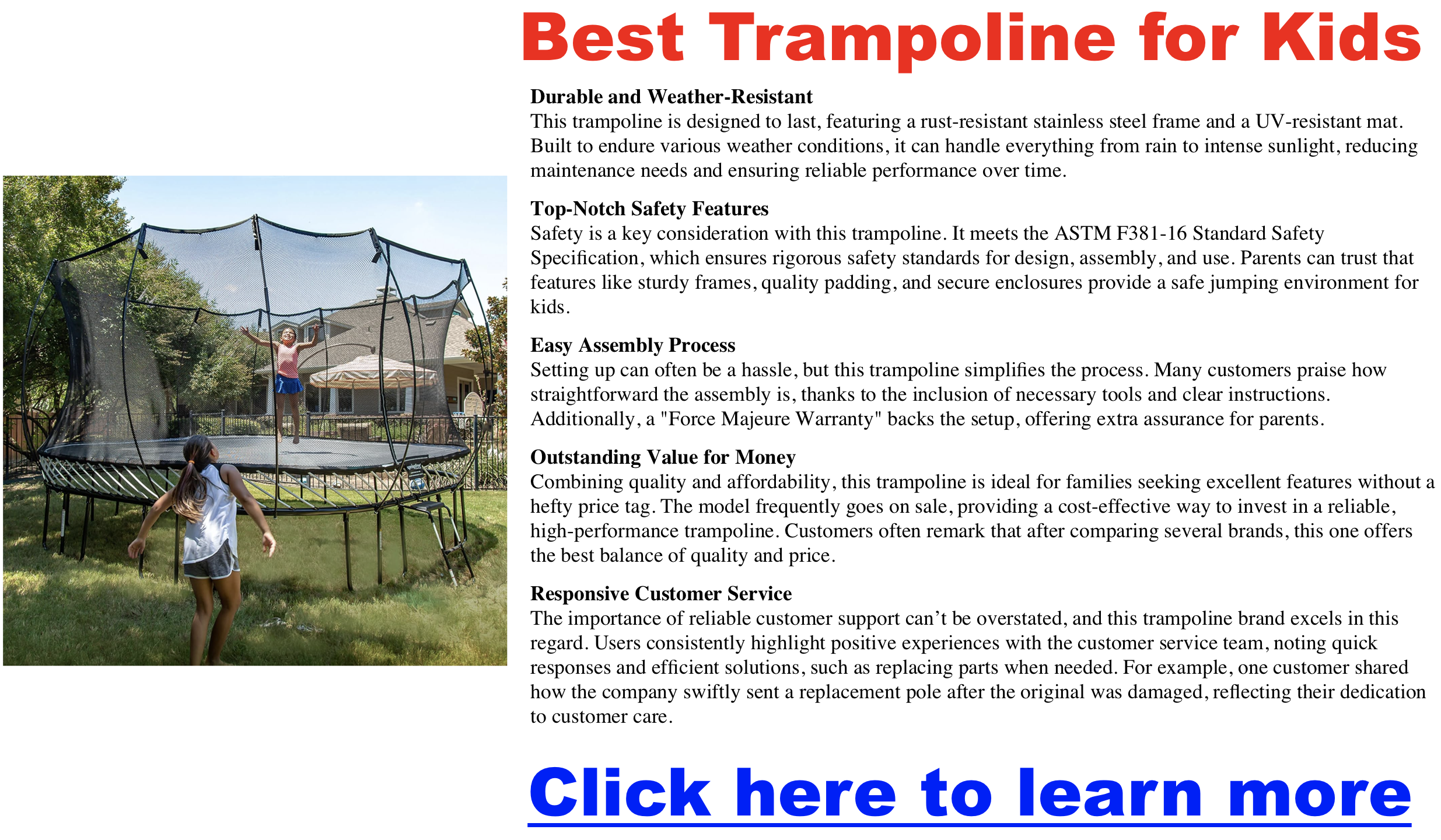The Ultimate Trampoline Buying Guide: Find the Perfect Bounce for Your Family
Buying a trampoline is an exciting investment, bringing hours of fun, physical activity, and family enjoyment. To make the best choice, it’s essential to consider who will use it, how much space you have, safety features, budget, accessories, and maintenance. This comprehensive guide will walk you through each step clearly and confidently, ensuring you pick the right trampoline for your home and family.
Who’s Jumping? Identifying the Perfect Trampoline Users
Understanding who will be using your trampoline is your first step in finding the perfect fit:
| User Type | Recommended Trampoline | Special Considerations |
|---|---|---|
| Young children (under 10) | Small Round (8-10 feet) | Maximum safety features like netting and padding |
| Families & casual jumpers | Medium-Large Round (12-14 feet) | Space for multiple jumpers, standard safety features |
| Teens & Gymnasts | Rectangular or Large Round/Oval (15+ feet) | Superior bounce, ideal for tricks, higher weight capacity |
Knowing who will use the trampoline most helps guide the size, shape, and safety features you should prioritize.
Measuring Your Backyard: Finding the Perfect Fit
Before shopping, grab a tape measure and verify your space:
- Ground Clearance: Plan for at least 2 feet of clear space around the entire trampoline.
- Overhead Clearance: Ensure at least 24 feet of vertical clearance to prevent accidents with trees, power lines, or buildings.
Practical Example: 14-foot Round Trampoline
- Diameter with clearance: Approximately 18 feet of total ground area
- Vertical Clearance: Minimum of 24 feet overhead
Visualizing this clearly will help avoid surprises on installation day.
Choosing the Best Shape and Size for Your Needs
Every trampoline shape has distinct advantages and limitations:
| Shape | Best For | Pros | Cons |
|---|---|---|---|
| Round | Casual/family jumping | Affordable, safe, bounce directs jumpers to center | Limited bounce height/tricks |
| Rectangular | Gymnasts, advanced users | Higher bounce, ideal for tricks | More expensive, larger footprint |
| Oval | Families with multiple users | Large jumping surface, fewer collisions | Less bounce compared to rectangular |
| Octagonal | Multiple jumpers | Balanced bounce, stable, good for groups | Less common, pricier |
Tip: Choose a trampoline shape and size that fits your specific usage scenario, ensuring both safety and enjoyment.
Making Safety Your Priority
Safety is critical, especially with children involved. Here are essential safety features to look for:
- Safety Nets: Always choose trampolines with a sturdy, zippered net enclosure to prevent falls.
- Spring Padding: Thick padding covering springs reduces injury risk.
- Galvanized Steel Frame: Ensures durability, stability, and resistance to rust.
- Springfree Trampolines: Innovative design eliminates traditional metal springs, significantly reducing injury risk.
Recommended Safety Checklist:
- ✅ Safety Net Enclosure
- ✅ Thick Spring Padding
- ✅ Rust-resistant Galvanized Steel Frame
- ✅ Consider Springfree Options for ultimate safety
Budget Wisely: Understanding Trampoline Pricing
Prices vary widely based on size, shape, and quality:
| Size | Typical Price Range | Recommended For |
|---|---|---|
| Small (8-10 ft) | $200–$900 | Young children, casual use |
| Medium (12-14 ft) | $400–$1,500 | Families, multiple jumpers |
| Large (15-17 ft) | $1,000–$3,000 | Advanced jumpers, gymnastics practice |
Budgeting Tip: Look for trampoline sales during early fall or late summer, as retailers often offer significant discounts.
Accessories that Add Safety and Fun
Proper accessories improve your trampoline’s safety, usability, and durability:
- Ladders: Essential for easy, safe access, especially for younger children.
- Weather Covers: Protect your trampoline from rain, UV rays, and snow to extend its life.
- Anchor Kits: Secure your trampoline to prevent shifting or tipping in windy conditions.
| Accessory | Cost | Importance |
|---|---|---|
| Ladder | $20–$80 | Essential for safe entry, especially for kids |
| Cover | $40–$150 | Essential in harsh climates |
| Anchor Kit | $30–$100 | Essential for stability in windy areas |
Installation & Maintenance Tips for Longevity
Proper setup and care keep your trampoline safe and functional:
- Above-ground trampolines: Ensure your ground is flat, level, and clear of debris.
- In-ground trampolines: Require professional installation for drainage and stability.
Maintenance Checklist:
- Inspect regularly for wear and tear (springs, net, padding).
- Tighten bolts and check frame stability monthly.
- Cover or dismantle in harsh winters to protect the structure.
Trampoline Brands You Can Trust
These top-rated brands combine quality, safety, and customer satisfaction:
- Skywalker: Best budget-friendly, reliable, good safety standards.
- Springfree: Unmatched safety features, spring-free innovation.
- Zupapa: Excellent durability, superior padding, and warranty coverage.
Answers to Common Trampoline Questions
Is trampoline jumping safe for kids?
Yes, when proper safety features and supervision are in place. Always ensure a safety net, padded springs, and supervised jumping for young children.
How long do trampolines typically last?
Quality trampolines typically last 5-10 years with proper care, including weather protection and regular maintenance.
Are Springfree trampolines worth the extra cost?
Yes, especially if safety is your highest priority. Springfree trampolines reduce injury risks significantly compared to traditional models.
Do trampolines require professional installation?
Most above-ground trampolines can be assembled DIY-style, while in-ground models usually require professional help to ensure safety and stability.
How do you protect a trampoline from harsh weather?
Use weather covers, anchor kits, and consider disassembling or securely covering during harsh winter months.
Ready to Jump?
Now you have the tools and knowledge to choose the perfect trampoline. Evaluate who will use it, measure your space, prioritize safety, and budget accordingly. With proper accessories and maintenance, your trampoline will offer years of fun and fitness for your entire family!


